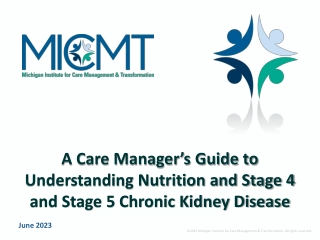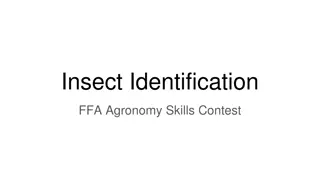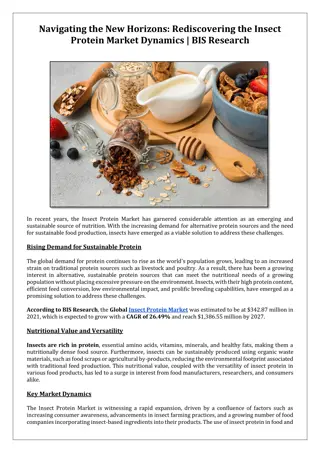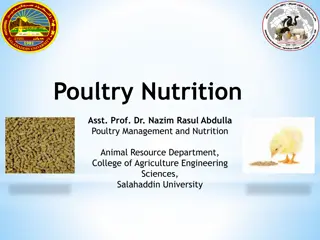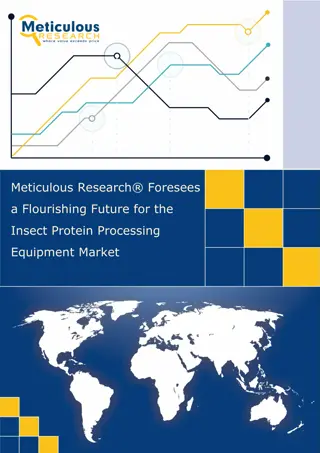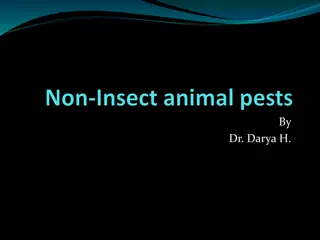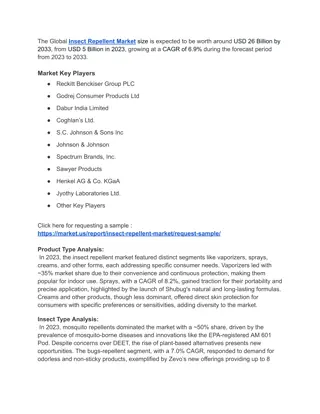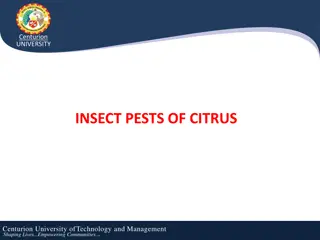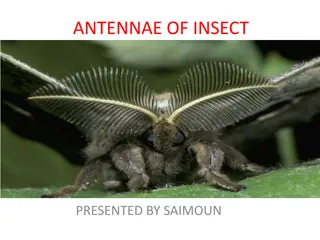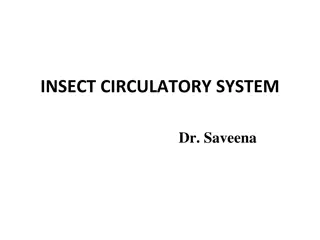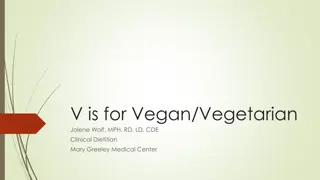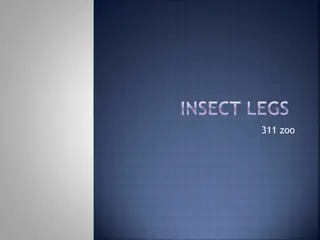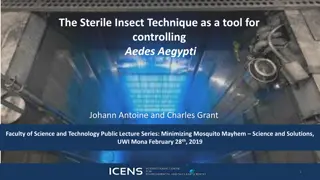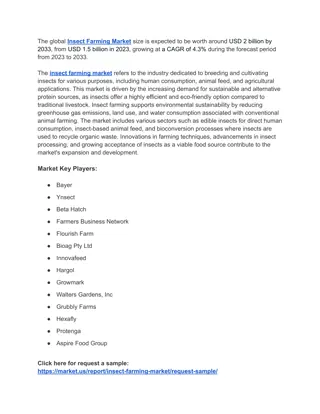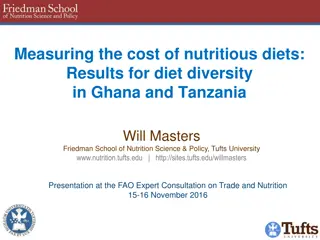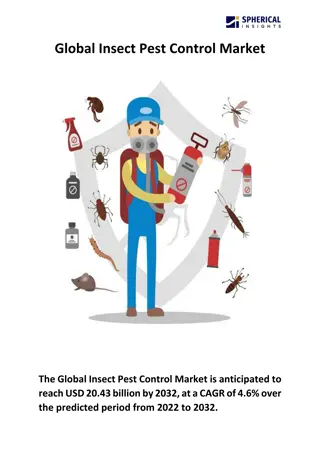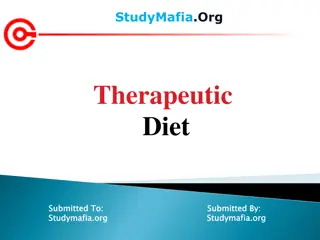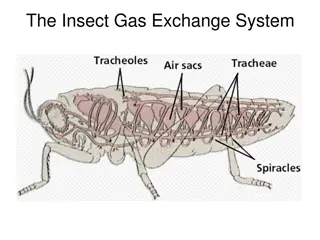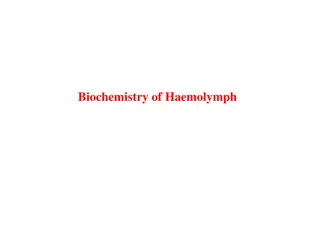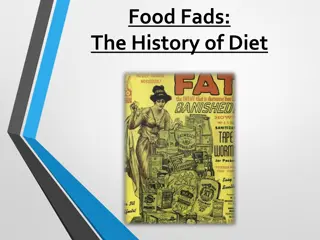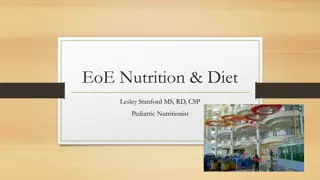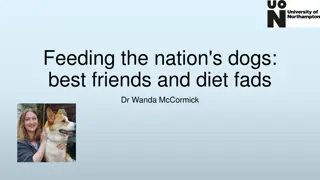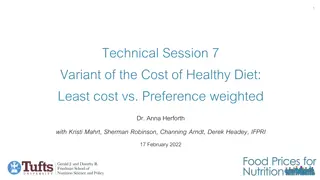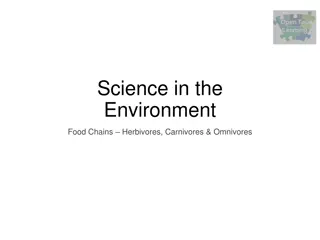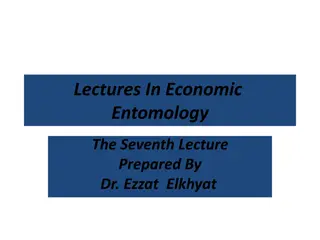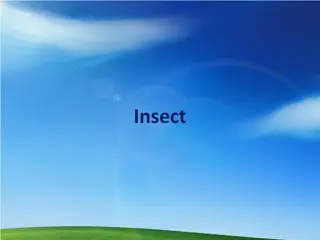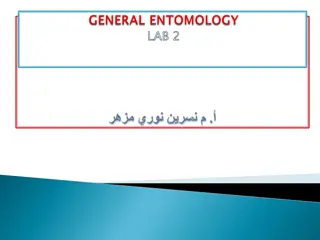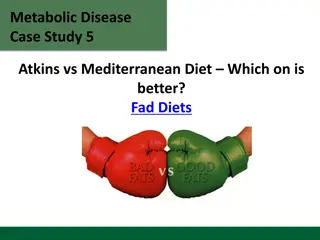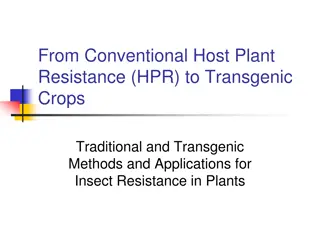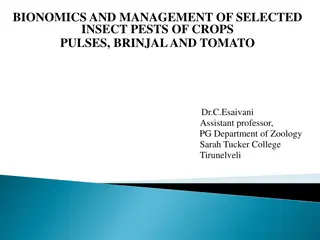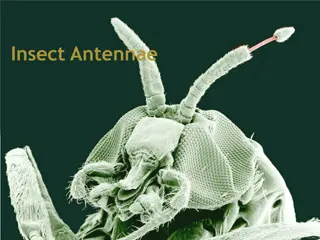Understanding Nutrition for Stage 4 and Stage 5 Chronic Kidney Disease
A comprehensive guide for care managers to understand the importance of nutrition in managing kidney disease and its impact on patients with diabetes, cardiovascular disease, and hypertension. Covers current recommendations, individualized diets based on lab values, and the evolution of kidney diets
3 views • 36 slides
Insect Abdominal Structures and Appendages: An Overview
The abdomen of insects plays crucial roles in respiration, reproduction, digestion, excretion, and metabolism. The number of abdominal segments varies across species, with reductions and modifications seen in different insect groups. From the propodeum to pregential and postgenital segments, each pa
1 views • 6 slides
Sustainable Rice Production in Pakistan: Challenges and Strategies
Pakistan's economy heavily relies on rice exports, with the country being a significant producer and exporter. However, challenges such as pesticide residues, major insect pests, and diseases threaten rice production. Key parameters for production include cultivation of improved varieties, pest mana
2 views • 42 slides
Insect Identification for FFA Agronomy Skills Contest
Explore a variety of insects including the Alfalfa Weevil, Aphid, Army Worm, Assassin Bug, Bean Leaf Beetle, Black Cutworm, Chinch Bug, Colorado Potato Beetle, Common Stalk Borer, Corn Earworm, Corn Rootworm, Cricket, Cucumber Beetle, European Corn Borer, Flea Beetle, Grasshopper, Green Lacewing, Gr
1 views • 37 slides
Navigating the New Horizons: Rediscovering the Insect Protein Market Dynamics
According to BIS Research, the Global Insect Protein Market was estimated to be at $342.87 million in 2021, which is expected to grow with a CAGR of 26.49% and reach $1,386.55 million by 2027.
2 views • 2 slides
Poultry Nutrition
Developments in poultry nutrition have led to increased productivity in the industry over the past 20 years. The focus is shifting towards life-cycle feeding programs for different bird classes rather than individual diets. Poultry diets consist of various feedstuffs providing essential nutrients fo
2 views • 33 slides
Insect Protein Processing Equipment Market Worth $210.6 Million by 2029
The insect protein processing equipment market is driven by innovations in insect protein processing equipment, the increasing focus of insect protein manufacturers to reduce production costs, increased investments in the insect-based protein industry, and the rising demand for insect protein in the
0 views • 3 slides
Understanding Non-Insect Pests in Agriculture
In this lecture, we delve into important non-insect pests affecting agriculture, such as nematodes, mites, snails, slugs, crabs, millipedes, birds, rodents, and more. Learn about their systematic positions, damages they cause, and characteristics. Explore the world of millipedes and centipedes, thei
0 views • 15 slides
Insect Repellent Market: Strategies for Success in a Competitive Market
The Global Insect Repellent Market size is expected to be worth around USD 26 Billion by 2033, from USD 5 Billion in 2023, growing at a CAGR of 6.9% during the forecast period from 2023 to 2033.\n\nClick here for requesting a sample : \/\/market.us\/
1 views • 3 slides
Insect Pests of Citrus: Identification, Behavior, and Management
Insect pests such as citrus butterfly, fruit-sucking moth, leaf miner, rust mite, and bark-eating caterpillar pose significant threats to citrus plants. These pests can damage citrus seedlings and various fruit varieties. Understanding their appearance, distribution, life cycle, and management techn
4 views • 14 slides
Understanding the Fascinating World of Insect Antennae
Insect antennae, also known as feelers, play a crucial role in sensory perception for insects. They help in detecting chemicals, perceiving various stimuli, and even aid in specialized functions like communication and prey-catching. The structure of antennae varies across insect species, showcasing
0 views • 11 slides
Insect Circulatory System: Overview and Functions
The insect circulatory system comprises an open type, where blood flows through the body cavity. Divided into three sinuses, it houses vital organs such as the heart and nerve cord. The dorsal vessel acts as the main organ of circulation, along with accessory pulsatile organs that supply blood to ap
0 views • 19 slides
Understanding Vegetarian Diets: Benefits and Varieties
Discover the different types of vegetarian diets, health benefits, reasons to choose a vegetarian lifestyle, and insights into weight loss considerations. Learn how plant-based diets can improve heart health, lower diabetes risk, and explore the importance of making healthy food choices within a veg
0 views • 43 slides
Understanding Insect Legs: Anatomy and Adaptations
Explore the intricate anatomy of insect legs, comprising segments like coxa, trochanter, femur, tibia, and tarsus, each serving specific functions for locomotion. Discover how these legs are adapted for diverse tasks like walking and running in different insect species.
0 views • 18 slides
Utilizing Sterile Insect Technique for Aedes Aegypti Control
The Sterile Insect Technique (SIT) is a biologically-based method used to manage key insect pests by releasing sterile insects to decrease population reproduction. This technique, developed through genetic manipulation and ionizing radiation, has been instrumental in controlling insect populations l
0 views • 13 slides
Insect Farming Market
The global Insect Farming Market size is expected to be worth around USD 2 billion by 2033, from USD 1.5 billion in 2023, growing at a CAGR of 4.3% during the forecast period from 2023 to 2033.\nClick here for request a sample: \/\/market.us\/report\
1 views • 4 slides
Measuring the Cost of Nutritious Diets in Africa: Insights from Ghana and Tanzania
Results of a study on measuring the cost of nutritious diets in Ghana and Tanzania have been presented by Will Masters from Tufts University. The study, funded by UKAid, explores the affordability of nutritious diets in Africa and the trends in food prices. Various food price indexes and indicators
4 views • 24 slides
Guide to Planning Balanced Diets for All Age Groups
Learn about the importance of balanced diets, nutritional needs for different age groups, and how to plan balanced menus using the food pyramid. Discover tips for weaning babies onto solid foods, including the introduction of iron-rich cereals and vitamin C sources. Ensure babies' diets are free fro
0 views • 39 slides
Understanding Special Diets and Managing Obesity
Explore the impact of nutrients on our bodies, causes of special diets, health issues linked to certain diets like obesity and vegetarianism, and dietary guidelines to manage conditions like CHD and Coeliac disease. Delve into the challenges of childhood obesity in Ireland, reasons for overeating, h
0 views • 37 slides
Global Insect Pest Control
The Global Insect Pest Control Market is anticipated to reach USD 20.43 billion by 2032, at a CAGR of 4.6% over the predicted period from 2022 to 2032.
1 views • 4 slides
Understanding Therapeutic Diets for Health Improvement
Therapeutic diets play a crucial role in managing medical conditions by modifying regular diets. These diets are personalized to address specific health concerns and are recommended by healthcare professionals. By controlling the consumption of certain foods or nutrients, therapeutic diets aim to im
0 views • 19 slides
Understanding the Insect Gas Exchange System
The insect gas exchange system involves spiracles, tracheae, and tracheoles that facilitate the exchange of gases to support respiration in insects. Spiracles lined with chitin control airflow, while tracheae and tracheoles enable oxygen to dissolve into the haemolymph through passive diffusion, sup
0 views • 18 slides
Understanding the Biochemistry of Insect Hemolymph
Insect hemolymph, also known as blood, plays a crucial role in maintaining the tissues throughout the body. It consists of plasma containing hemocytes suspended in a fluid rich in various chemicals. The pH of the hemolymph ranges between 6.4 and 6.8, with variations in volume across different insect
0 views • 9 slides
Embracing Insect-Based Diets for a Sustainable Future
Emphasizing the urgency of meeting the growing protein demand sustainably, the article explores the benefits of entomophagy - consuming insects as food. Experts advocate for insect-based diets to address environmental concerns, citing insects as a rich protein source with lower greenhouse gas emissi
0 views • 6 slides
Decoding Super Diets: What Works and What Doesn't
Explore the truth behind popular diets like Paleo, Blood Type Diet, Anti-Inflammatory Diet, Atkins Diet, South Beach Diet, Weight Watchers, Jenny Craig, Nutrisystem, HMR Diet, and Herbalife. Learn about meal replacers, the effectiveness of various diets, and why sustainable lifestyle changes are the
0 views • 14 slides
Exploring the Fascinating History of Fad Diets and Vegetarianism
Uncover the intriguing journey of fad diets and vegetarianism, from the Victorian era's vegetarian movement to Horace Fletcher's unique chewing diet. Learn about the exaggerated beliefs surrounding fad diets and the origins of vegetarianism in Britain, including Fletcherism's emphasis on chewing foo
0 views • 11 slides
Understanding Elemental Diet in Pediatric Nutrition for EoE Treatment
Eosinophilic esophagitis (EoE) is a condition where certain foods trigger an inflammatory response. Elimination diets like the elemental diet, which involves amino acid-based formulations, have shown positive results in treating EoE in children. Implementing specific exclusion diets and milk elimina
0 views • 12 slides
Understanding Dog Diets in the UK: Trends and Influences
Investigating dog diets in the UK, this study explores the types of diets fed to dogs and the impact of human diet types on them. The research delves into reasons behind choosing specific diets, utilizing a questionnaire distributed via social media and promoted by the BBC. Results show a variety of
0 views • 13 slides
Understanding Cost Variants in Healthy Diets: Least Cost vs Preference Weighted
The discussion delves into the concept of least-cost versus preference-weighted healthy diets, highlighting the differences in cost and food selection. It explores how preference weighting takes into account food preferences of low-income consumers, providing insights into the affordability and cult
0 views • 18 slides
Understanding Animal Diets: Herbivores, Carnivores, and Omnivores
Explore the world of animal diets by learning about herbivores, carnivores, and omnivores. Discover what different animals eat and the classifications based on their diet preferences. Engage in activities to distinguish between herbivores, carnivores, and omnivores, and understand the special charac
0 views • 14 slides
Understanding Economic Entomology: A Focus on Pest Management in Horticultural Plants
Explore the world of economic entomology and delve into the study of insects that either benefit or harm humans and their products. Learn about the general definitions of pests, taxonomy of pests, and why insect pests are considered the most important group of pests. Discover the impact of insect pe
0 views • 24 slides
Understanding Insect Life Cycles and Management Strategies
Exploring the world of insects, this content delves into the life cycles and damage caused by key insect pest groups, emphasizing the importance of knowing their life stages for effective pest management. It covers insect development, how insects cause injury, pest control principles, threshold leve
0 views • 20 slides
The Anatomy of an Insect Head: A Detailed Look
Explore the intricate structures of an insect head, including the segmentation, sclerites, sutures, and specialized features like the occiput and ocular sclerites. Discover the unique characteristics that define the head capsule in insects through frontal, lateral, dorsal, and posterior views, shedd
0 views • 10 slides
Exploring the Impact of Different Diets on Earthworm Growth Rates
This project delves into how various diets affect the growth rates of earthworms. By providing different food sources to earthworms and monitoring their growth, the study aims to uncover the diet that promotes the fastest growth. The project also includes details on earthworm anatomy, the setup of t
0 views • 10 slides
Comparing Atkins and Mediterranean Diets for Metabolic Disease: A Case Study
In this case study, the Atkins and Mediterranean diets are compared in terms of their impact on metabolic health. The Atkins diet focuses on low carbohydrate intake, leading to gluconeogenesis and changes in insulin levels. On the other hand, the Mediterranean diet emphasizes unsaturated fats from p
0 views • 19 slides
Evolution of Plant Resistance to Insects: From Traditional Methods to Transgenic Crops
The transition from Conventional Host Plant Resistance (HPR) to Transgenic Crops for insect resistance in plants has a rich history dating back to the 1790s. Traditional methods like breeding for Hessian fly resistance in wheat have paved the way for modern techniques. Factors influencing insect res
0 views • 36 slides
Bionomics and Management of Insect Pests in Crops: Insights and Strategies
Explore the bionomics and management practices for key insect pests affecting crops like pulses, brinjal, and tomato. Learn about the life cycles, damage caused, and effective control measures for pests such as the greasy cutworm and plume moth.
0 views • 30 slides
Insights into the Career Journey of Jarrod Leland at Novozymes
Jarrod Leland, a Ph.D. holder in Entomology from VT, transitioned from being a Government Scientist to a Scientist at Novozymes focusing on insect pathogens. With vast experience in the field, he now leads a team of 20 individuals, emphasizing the use of insect pathogens as alternatives to chemical
0 views • 17 slides
Exploring the Fascinating World of Insect Antennae
Insect antennae serve as vital sensory organs for these creatures, offering more than just a sense of touch. They play key roles in detecting odors, changes in humidity, sounds, and air speed. This article delves into the diverse types of insect antennae, showcasing their unique structures and funct
0 views • 19 slides
Insect Management Update for Corn, Sorghum, and Sugarcane Aphids
Explore the latest updates on insect management for corn, sorghum, and the impact of sugarcane aphids. Learn about potential yield loss, thresholds for management, best insecticides, current issues in corn, and strategies for effective pest control. Stay informed to protect your crops and optimize p
0 views • 33 slides
